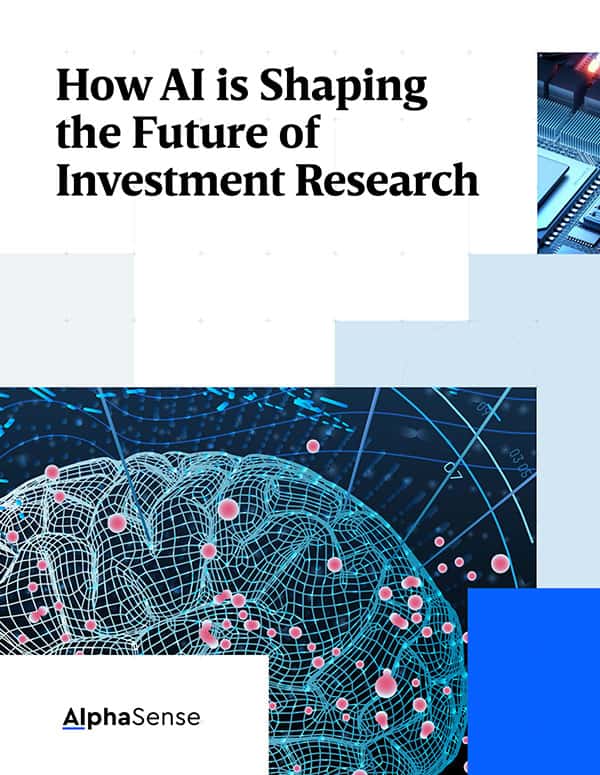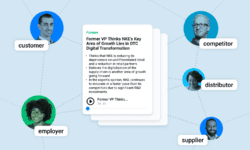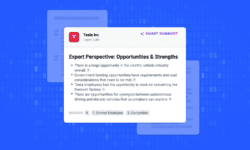Technological advances have transformed how analysts and fund managers make investment decisions in today’s modern financial markets, but you may be surprised at how slow their decision making processes can be. Many investment analysts and managers suffer from option paralysis due to a highly saturated financial market and an overwhelming amount of public information available online.
According to research conducted by Orgvue, 92% of senior business leaders sampled believe that time to decision is a key success metric for organizations but in contrast, 89% believe that organizations are taking too long to make decisions. However, there are many research tools available that can help investors overcome option paralysis and make faster, more confident decisions.
AlphaSense is a leading AI-based market intelligence platform that provides investment research through Expert Insights alongside an extensive universe of private, public, and premium content. Expert Insights can be used as a primary investment research tool to conduct fast and comprehensive due diligence on any target company, industry, or opportunity.
Investment researchers can harness the combined power of expert perspectives, innovative artificial intelligence (AI) technology, and effective research methods to speed up their time to decision without sacrificing thoroughness. Below, we explore four effective ways that analysts and fund managers can improve their time to decision with Expert Insights.
Understanding Time to Decision
The formal definition for “time to decision” is exactly how it sounds: the amount of time it takes to get from initial consideration to commitment to a final decision.
Due to the mass digitization of financial data available online, one would assume that investment decisions can be made more quickly and confidently than ever before. However, time to decision is something that many organizations and investment managers struggle to shorten given the complexity of today’s financial landscape and the sheer amount of information available online through intelligence platforms and instant digital communication.
It’s not that investors aren’t aware that making fast decisions are important, but rather, it’s that there are potential gaps in their primary investment research that can lead to inaccurate decisions and result in decision paralysis.
It’s critical that organizations address obstacles for timely decisions because delayed decisions can directly impact efficiency, team performance, and ultimately revenue earned. In fact, according to a second study by Orgvue, faster decisions correlated with 16% higher annual revenues than slower counterparts.
For analysts and fund managers, slow decisions can result in missed investment opportunities and other losses that negatively impact a fund’s profitability. At the same time, risk is inherent in the investment world, and rushed or irresponsible decision-making can have disastrous effects.
So how can you find the right balance between efficient time to decision and confidence that your research has been thorough? Below we explore four best practices to accelerate your primary investment research and speed up your time to decision.
Top 4 Ways to Speed Up Time to Decision
AlphaSense is an all-in-one market intelligence platform that eliminates manual processes in financial research, provides on-demand access to thousands of sources, and instantly surfaces millions of data points from a universe of content. Centralized and process-driven primary research can lead to confident and rapid decision making as follows:
1. Gain Deeper Context with Expert Transcripts
One of the key ways that analysts and fund managers can speed up their time to make an investment decision is by reading expert transcripts in order to gain a deeper context of a potential opportunity. Firsthand expert perspectives from former executives, customers, competitors are critical when formulating investment strategies and can be easily found in AlphaSense’s extensive expert transcript library.
Conducting initial due diligence with traditional research methods like sourcing public financial documents, analyzing historical data, or following company news can be laborious and time consuming. However, building comprehensive context is effortless with on-demand access to an alternative data source, like Expert Insights, and can ultimately accelerate your decision making process.
For example, perhaps a particular target company is performing exceptionally well, or a new market is opening up that seems urgent to enter. Investment researchers can leverage AlphaSense’s searchable database of expert transcripts and filter any thematic search by expert name, industry, topic, company and more. Furthermore, each transcript provides a concise summary to expedite your reading process.
The AlphaSense platform also allows analysts and fund managers to receive customized, automated alerts for specific topics, companies, and industries they are targeting to quickly pinpoint sources that are most relevant to their research. Investment researchers can ramp up quickly on any topic using Expert Insights to gain deeper context of a target opportunity and make faster decisions with more clarity.
2. Accelerate Research with AI Technology
Leveraging an AI-based market intelligence platform, like AlphaSense, to conduct your primary research can eliminate tedious tasks required by manual research that hinder confident decision-making. AI technology brings forth a new dimension to market intelligence that allows investment researchers to effortlessly extract quality insights from large sources of financial data.
AlphaSense’s powerful AI platform aggregates thousands of financial documents, broker research, news releases, and expert transcripts to extract millions of data points into one central database. With AI-driven technologies, like generative AI (genAI) and natural-language processing (NLP), researchers can gain instant insights into any topic, industry, or company.
With over 10+ years of investment in AI development, AlphaSense allows users to refine and personalize their primary investment research with powerful AI search tools like: Sentiment Analysis, Smart Synonyms™, Smart summaries, and AI Assistant. In a survey conducted by AlphaSense, 54% of respondents in financial services would rather take a pay cut than lose access to AI tools.
Conducting due diligence and comprehensive research is labor intensive and can actually place investment professionals at a disadvantage by making slower decisions if they are not leveraging AI-driven efficiencies to speed up their investment research. AlphaSense’s award-winning AI can accelerate investment research and empower investment professionals to make faster decisions.
Learn how AlphaSense revolutionizes the way analysts and fund managers conduct investment research in our white paper, The Future of Primary Investment Research.
3. Fill Research Gaps with Expert Calls
Another factor that can lead analysts and fund managers to option paralysis is the uncertainty created by gaps in their investment strategies. Customized calls with subject matter experts from a range of industries can provide granular insight into niche topics like how a company operates, industry nuances, and likely future trends.
Many analysts and fund managers access industry experts through traditional expert networks, however AlphaSense streamlines access to quality industry experts with our Expert Call Services that allow you to easily dive deeper into research subjects straight within the platform.
In the AlphaSense platform, you can schedule one-on-one calls with any of the thousands of experts available in the expert transcript library to ask specific questions and extract granular, personalized insights. Expert Call Services allows investors to gather last-mile insights from industry experts to fill gaps in their investment strategies, leading to quicker decisions.
AlphaSense also provides industry-leading compliance to mitigate risks of exposure to material non-public information (MNPI) by thoroughly vetting both industry experts and investment analyst for each expert call. Our customizable compliance programs offer tailored solutions to ensure each custom call adheres to company-specific standards and laws, securing operational excellence.
These rigorous compliance protocols provided by AlphaSense allow analysts and fund managers to make faster investment decisions in confidence.
Learn more about our dedicated compliance process in our blog, Exploring the Compliance Process of Expert Insights.
4. Establish a Decision-Making Process
Finally, being process-driven can help you improve time to decision by creating consistency that fosters efficiency. Establishing an effective decision-making process by including checklists and AI tools can ensure that investment researchers don’t miss critical steps that could delay a decision down the line.
By following a deliberate process, analysts and fund managers ensure confidence in their choices, reduce or eliminate second-guessing, and secure success in their opportunities.
Here are seven crucial steps to consider when making an investment decision:
- Identify the Opportunity – Define the target opportunity and articulate what decision needs to be made about it.
- Gather Contextual Information – Conduct due diligence and comprehensive research on your target with Expert Insights.
- Identify Your Options – Deliberate potential options regarding your opportunity and filter out any weak or unlikely options.
- Evaluate the Information – Weigh the evidence and see how the background research you’ve conducted supports one or more of your decision options.
- Select Your Decision – Make an investment decision by selecting the best option for your needs.
- Implement the Decision – Take necessary action to ensure the decision is followed through for your opportunity.
- Review Your Decision – Evaluate your results, monitor performance in AlphaSense, and refine your process for future investment decisions.
Other points of consideration are: who else will be part of making this decision? Who is responsible for which steps in the research? How will you communicate this decision (i.e. calls, meetings). Formalizing your decision processes avoids backtracking and empowers you with confidence in your decision-making to shorten its length.
Make Faster Investment Decisions with Expert Insights
Analysts and fund managers may struggle canceling out the noise in their primary investment research and suffer from option paralysis. However, AlphaSense provides Expert Insights, centralized financial research, and powerful AI tools that revolutionize the way investors conduct primary investment research.
Discover how Expert Insights can maximize your return on time in our whitepaper, The Expert Insights Flywheel: Maximize Return on Your Time.
Speed up your time to decision with Expert Insights. Start your free trial today.





